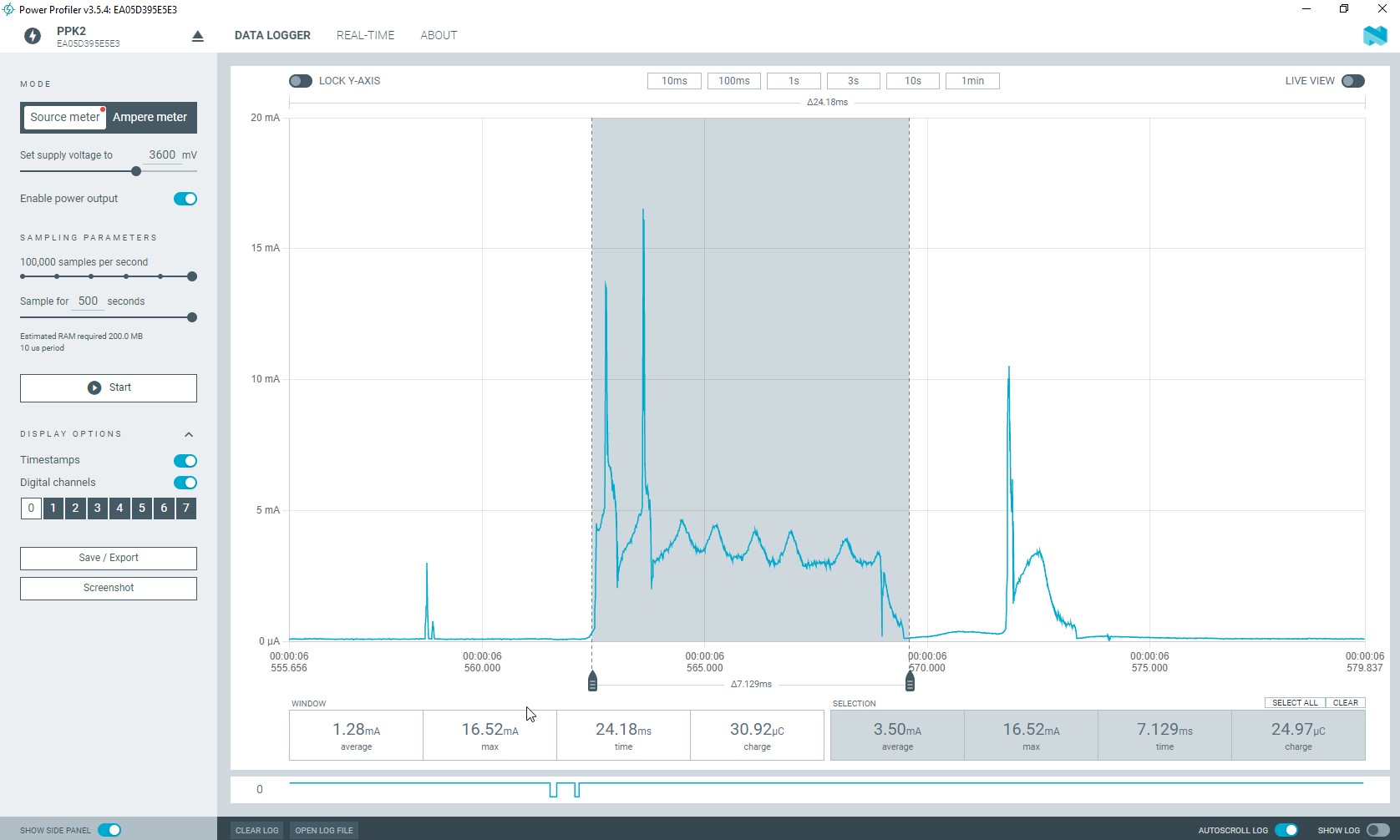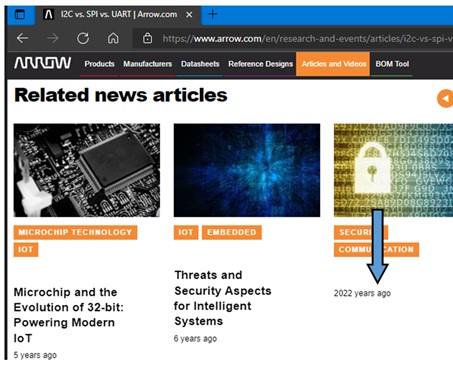|
You may redistribute this newsletter for non-commercial purposes. For commercial use contact jack@ganssle.com. To subscribe or unsubscribe go here or drop Jack an email. |
| Contents |
|
| Editor's Notes |

Tip for sending me email: My email filters are super aggressive and I no longer look at the spam mailbox. If you include the phrase "embedded muse" in the subject line your email will wend its weighty way to me.
Here's a nice article from the folks at Memfault about OTA updates for embedded Linux systems.
|
| Quotes and Thoughts |
13% of the code accounts for 90% of the problems; 2.5% account for 95% of big problems (Measuring Software Quality: A Case Study by Thomas Drake, IEEE Computer Nov, 1996) |
| Tools and Tips |

Please submit clever ideas or thoughts about tools, techniques and resources you love or hate. Here are the tool reviews submitted in the past.
From Scott Case:
|
You may have already seen this tool, but I've been getting a lot of mileage out of it lately and just thought I'd mention it. It's a device for measuring current by Nordic. It's not perfect, but for the price (about $90) it's pretty good. The software is simple and intuitive. The device can function as an inline ammeter or as a source. It's got some simple digital inputs, allowing you to make time correlations between logic and power events. Here's a link to Nordic's page about it, and below I'll paste a screenshot I took. I don't have any association with Nordic or stake in the product; I've just been impressed by it. There are, I'm sure, lots of tools out there with better specs and capabilities, but I've been very pleased with this one for the price.
https://www.nordicsemi.com/Products/Development-hardware/Power-Profiler-Kit-2

|
|
| A Wooden Transistor |
Researchers at the Wallenburg Wood Science Center, who apparently have nothing important to do, have come up with a new transistor that retards the state of the art by 60 years. Instead of using silicon, which is so rare that every beach in the world has mega-tons, their transistor is made from wood.
I guess process engineers struggling with ulcers from developing 3 nm EUV lithography will be relived at the 3 cm (30,000,000 nm) form factor, which will certainly make soldering these things much easier, even for Parkinson's patients. Switching at a blazing 1 Hz they will clearly revolutionize the next generation of electronics.
A rough calculation suggests that an iPhone made from these parts would be many tens of meters square. That would certainly discourage texting while driving. The transistors' switching speed means a phone call would only take a couple of billion years to connect. No specs were given for their power dissipation, but one does wonder about the danger of a conflagration from putting so much combustible material together.
I image the intelligence community would benefit when every tree can be a bug. Come to think of it, trees already have many species of bugs.
Anxious to exploit the technology, here I am processing transistors on my sawmill. This log contains some 200,000 transistors, which could yield a nice 20 KB memory:
 |
| On Employee Retention |
I'm hearing a lot of woes about employee retention lately. Anecdotally it seems engineers, particularly younger folks, are hopping around, perhaps searching out that perfect gig. I'm not sure what the answer is, if there is one. One could argue that this is a natural way for people to find their fit. From a management point of view, of course, things are a bit more problematic.
A reader who wishes to remain anonymous poses this question to Muse readers:
|
So we have lately struggled with personnel turnaround, it seems not due to unhappiness with our work environment. We have a really nice environment with separate offices for each developer and in general it is very constructive to work with other people there.
The majority of the people who left are young guys, with no or one to two years experience when joining us. They then leave within 1-2 years.
I get the idea they are using the opportunity as a stepping stone to get experience, which is perfectly fine.
We also have a fair amount of people who have been with us for 10+ and 20+ years. They are very capable people and could get another job if they wanted to.
The turnaround is killing our productivity a bit, because of retraining new people all the time and losing value knowledge.
I was wondering if:
- anyone has inputs on how one determine if a candidate, whether young or not can be assessed to get an idea if they are the type of person who will stay longer than 2-3 years?
- Is there any personality traits or tests that will assist in this?
- Can you more accurately find good people who will stay longer?
- Or has the world just changed so much that all the young guys want to change from one job to another for experience or money or change of scenery?
|
Any thoughts? |
| Your Cloud Product is My Problem |
There aren't many worthwhile newsletters in this industry, but one I always read and enjoy is from EmbeddedArtistry. Philip Johnston and crew put this monthly email together, and I highly recommend subscribing. It's free, and you can sign up here.
The latest has an article that says a lot about how we manage legacy products, and is reproduced here with Philip's kind permission.
|
Why Should We Buy Your Cloud-Powered Device?
There's a general pattern that is observed with connected devices:
- A company sells connected products. Those products interact with company-maintained servers.
- Sometime later, the company no longer wants to support the product/servers.
- Sales might be down, and the company cannot justify ongoing server and maintenance costs.
- The product may have reached the end of its support life, and the company is no longer interested in paying for servers or maintenance.
- Servers get turned off.
- Working products no longer function. Devices become e-waste, and users need to spend time and money replacing the products.
This time, Google is shutting down servers for Nest Secure and Dropcams on 8 April 2024. Fine, those devices have not been sold for years. But all of the hardware is tied to the cloud, so turning off the servers turns this functional hardware into useless bricks. Also, bricking cameras is one thing, but bricking home security systems is a completely different matter. Replacing a security system requires significant overhead in terms of purchasing and installing new components.
Google is offering discounts and upgrade paths for existing users, which is something. But it still requires financial outlay and generates significant e-waste.
However, they delivered a solution for the Stadia controllers, allowing them to remain useful even after ending support. But providing an alternative for servers is a lot trickier than enabling controllers to work with Bluetooth, so we don't hold out much hope for a solution to this e-waste problem.
As consumers, this is yet another reason on the long list of reasons that we don't want to buy your cloud-powered product. We get that it makes sense for your business. We get that it enables more capabilities for your users. But there are so few examples of good stewards over the medium- and long-terms, that it is increasingly difficult to justify the purchase of any device that depends on a company-owned server to operate.
We hope that you, as responsible designers, will consider how to make it possible for someone to support devices after your company is no longer interested in it and how to create paths for graceful degradation of functionality in the event that servers are shut down. |
|
|
|
|
| Failure of the Week |
From Authur Pragay:

From Jack Monegato:

Have you submitted a Failure of the Week? I'm getting a ton of these and yours was added to the queue. |
| Jobs! |
Let me know if you’re hiring embedded
engineers. No recruiters please, and I reserve the right to edit ads to fit the format and intent of this newsletter.
Please keep it to 100 words. There is no charge for a job ad.
|
I need to find someone in the UK (preferably they can easily get to South West and South Coast), with home.office working for an approx 3 month period to rewrite C/C++ for SMALL processors in the Arduino Framework, not high end of contract rates.
Yes it is Arduino but for many reasons like only EVER building 6 units including spares, and ability to archive all installation tools, with NO web installs and other bloat, then licensing issues etc etc. Using gcc/g++ is a way forward and repeatable with set versions and installation files saved for Windows/Linux/Mac.
Contact Paul at paul@pcserviceselectronics.co.uk.
|
|
| Joke For The Week |
These jokes are archived here.
From Maor Malka:
A chip designer heads to to the shop with engine problems. The car mechanic tells him there is a problem with the timing.
perplexed, the designer asks him if the issue is a setup or hold violation.
And there's this from Rick Ilowite. Check out the comment:

|
| About The Embedded Muse |
The Embedded Muse is Jack Ganssle's newsletter. Send complaints, comments, and
contributions to me at jack@ganssle.com.
The Embedded Muse is supported by The Ganssle Group, whose mission is to help embedded folks get
better products to market faster. |









